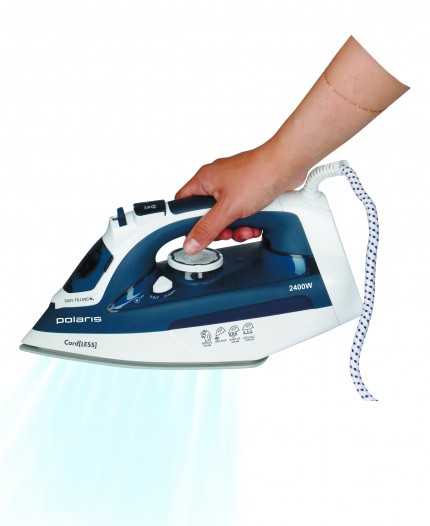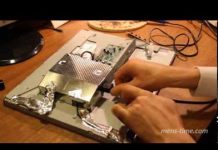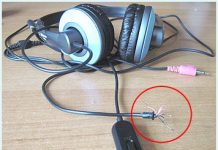Temperature control is carried out with a round wheel. It is located in the Azur iron and in other models on the body under the handle. When you turn the wheel to the right, the heating temperature increases, to the left, it decreases until the heating element is completely turned off.
The wheel acts on the thermostat by means of a special sleeve or steel angle and is attached to the body with latches. In the Scarlet iron and in other models, it is enough to pick up the adjusting disc with a screwdriver to make it come off.
The operating principle of the thermostat is based on various properties of metals. In the manufacture of this unit, two plates are soldered, made of metals with unequal coefficients of linear expansion. Thanks to these indicators, each plate behaves differently. Outwardly, it looks like this: under the influence of temperature, the common plate bends, causing the circuit to open, and the iron turns on.
To make sure that the temperature regulator is faulty, you will have to disassemble the iron completely.
The handle of the device and the plastic parts of the case are attached to the metal parts with latches or self-tapping screws. Even one manufacturer has many models, and they all have design features. But all species have common points.
To disassemble the iron, it is necessary to examine its sharp part, where there is one attachment point. For example, a Philips iron hides a self-tapping screw under the steam knob. To unscrew the screw, turn the handle all the way to the left and pull up. After removing the adjusting unit, you can unscrew the self-tapping screw. In the Brown model, the screw is hidden under the nozzle cover. You can remove the nozzle by slightly pulling it towards you. After removing it, free access to the screw opens. Other screws or latches are located under the back cover of the device.
After the plastic part of the case has been removed, the iron thermostat should be considered. In cold mode, the contacts must be closed. If there is a special device, it is better to ring the knot. If there is no device, you can clean the contacts with fine sandpaper, and then turn on the iron to the network.
To set up an iron, you can refer to statistics, which say that 50-60% of malfunctions occur due to the fact that a thermal fuse fails. This unit is disposable and reusable. Fuses of the first group, like kamikaze, are triggered only once. The unit is designed so that when the heating element reaches a temperature of 240 ° C, the circuit is broken. Further operation of the device without additional intervention becomes impossible.
More modern technologies involve the use of bimetallic parts. Such a thermal fuse is able to turn off the iron in extreme situations, and then turn it on again. If the iron does not work for this reason, the easiest way is to discard the knot and short the circuit. This can be done in different ways:
In each case, it is necessary to achieve reliable contact.
Another common ailment is a problem with the steaming system. Sometimes in the Bosch iron, the button that starts the process is strongly pressed, and steam is not supplied. Repairing a Bosch iron should begin by unscrewing the screw at the back and removing the back cover. Then you should carefully pull out the two buttons regulating the steam supply up. They are not screwed in and are held onto the bushings by friction. Then you need to unscrew the screw, after which the plastic handle should be easily removed.There are two pumps under the cover: one supplies water to the sprinkler, the other supplies water to the soleplate to create steam. The steam pump needs to be removed. At the bottom there is a ball that sticks to the bottom of the chamber due to scale. To eliminate the malfunction, you need to push the ball into the chamber and assemble the iron in the reverse order.
Whatever iron you have to repair, you must remember about safety and follow certain rules: turn on the device to the network only when it is necessary; do not try to fix the malfunction with wet hands; during repairs, the iron must be installed on a stable, non-conductive and heat-resistant coating.
VIDEO
Iron Braun SI 6595 FreeStyle has proven itself very well. This model has an automatic shutdown function (with no movement in vertical and horizontal position). So, this is a very convenient and necessary thing, however, it is this automation unit, in the main, that is the cause of the iron malfunction. The main symptoms - first, turn off the iron when ironing, tapping on the body or vigorous shaking is required. Then it stops turning on altogether, while the indicator just blinks. The reason for this is sticking of the motion sensor, possibly burning of relay contacts or malfunction of elements of the automation board.
The first way out is to take it to the service center.
Same model, only BRAUN TexStyle 540 it does not have this function initially (not 100% - judging by information from the Internet). When deciding on self-repair, you must understand what you are doing, since the safety of using this model decreases.
So let's start disassembly (repair) of the Braun 540 SI 6595 FreeStyle iron
First, remove the back cover by unscrewing two bolts.
Then you need to remove the white cover that goes from the back of the iron to the regulator. About 3-4 centimeters from the back wall, we pry it with a screwdriver (we will see a groove there) and it can be easily removed. Remove the temperature regulator knob (pry it off with a slotted screwdriver, slightly). ATTENTION! There is a spring (for the ratchet), do not lose it when turning the iron. Now we can see the whole economy from behind.
Next, we remove the control unit and the connector on the heating element (it is closed with a white cap, for which, in fact, the control unit is held. We will have to make a little effort, push the heater connector back). Because the conductors of the supply cable are soldered in the block, then after the connector has been slightly moved from its place, they will also be pulled. There is no need to unscrew the screws holding the power cable.
Now you need to remove the indicator along with the power cable. If you look inside, the transparent indicator body is held by two latches from the iron body. We release the latches one by one (for this we squeeze them in depth with a long thin screwdriver) and pull the indicator back. Now you can take out all the electronic stuffing.
The body, in principle, can be further disassembled, for further acquaintance (you need to remove the front cover of the splash guard, remove the tube and unscrew the TORX T20 self-tapping screw, then there are 2 body latches behind the iron, release them and the plastic body is removed completely from the sole of the iron). Or you may not disassemble.
Now why is it disconnecting. If you look at the control unit (filled with compound), then on the left (if you look from the back of the iron) you will see a white parallelepiped. Here it needs to be opened. Dig out the compound and see that the lid is held by the protrusions from the ends. There will be a roller inside, which should move FREELY along the contact rails.It is necessary to remember its position after opening. Then clean it and at the same time the contacts inside the case (this is a horizontal position sensor).
When I took it apart, it turned out that the entire video was covered in some kind of paraffin and the contacts were dirty. The most important thing is its MOBILITY in the body. After that, I put everything in place, put it together, and the iron began to continue working. This is how I managed to do it. Poking around with him for a long time, several hours. Either it’s not the sensor, but the unit, it’s easier to put a new one for repair. Although I dig deeper (I cleaned the entire compound), I found a microcircuit, a relay, several transistors, etc., etc. So I don't recommend picking the compound further, except near the sensor.
This method - picking the compound - is not always and not always successful for everyone. There are easier ways
- bite the white wire closer to the block and connect it to the brown one. Do not bite off the brown one, just peel and connect, then you can wrap it with heat shrink tape. In this case, we do not throw the block away - we use it to operate the LED.
- if the LED does not work or incomprehensible sounds are heard in the unit - breakdown or the relay rattles, bite it off completely. We connect the white and brown wires. Everything will work except for the indicator. We connect the terminals from the indicator board to the leftmost (when viewed from the top from the back of the iron) contact through a 200-300 kOhm series resistor and the second output to the rightmost connector. Without a resistor, the LED will immediately burn out, since we connect it to 220V. Everything, the iron is working, the power indicator too. Resistor and connections can be soldered and packaged in heat shrink tubing. We no longer use the automation unit. We collect Braun SI 6595 FreeStyle iron after repair in reverse order. The iron works fine further, with the exception of the auto-shutdown chip when idle - we sacrifice this - not the most terrible and necessary in the function of the iron.
This topic provides a photo with explanations:
dismantling the iron,
repairing it
So, your iron has broken down at your home, no matter from which manufacturer, the question arises: "How to fix the iron."
Testing of the electrical circuit, as for all household appliances, is carried out with a probe for example OP-1
or with a digital multimeter.
There is no significant difference in the schemes of irons from different manufacturers.
For a general presentation, consider a sequential electrical circuit of connections iron Philips
The first wire of the phase or zero potential from an external power source has a plug-in connector with the terminal, from the terminal through the thermostat, the wire goes to the heating element. The second wire from the external power source has a contact detachable connection with the second terminal, from the second terminal the electric circuit has a serial connection passing through a thermal fuse and closes at the second terminal of the heating element. The control lamp and the fuse are connected in parallel to the two contact connections of the heating element.
The electrical circuit is closed on the heater - heating element and light bulb. The thermostat sets a certain temperature regime for heating the iron.
Closing and opening of the electrical circuit occurs in the thermostat itself due to a change in the bimetallic plate under the influence of the heating and cooling temperature of the heating element. The reasons for the malfunction of the iron are as follows:
a break in the cord wiring at the base of the plug;
mechanical damage to the wiring of the cord along its entire length;
burnout of the heating element of the sole of the iron;
oxidation of the contacts of the bimetallic plate of the thermostat;
blown thermal fuse
What can be replaced here during testing:
replace the cord;
replace the plug;
clean the thermostat contact;
replace the thermostat;
replace thermal fuse
Replacing the heating element in case of its malfunction, which is the sole of the iron, does not make sense, since the sole of the iron itself is more than half the cost of the iron itself. In this case, the sole of the iron is thrown away, everything else from the iron goes to spare parts.When disassembling the iron, care should be taken to avoid damaging the iron body.
It should be remembered that testing for detecting a malfunction of the iron is carried out in a passive way without connecting to an external power source. Immediately before connecting the iron to an external power source, it is necessary to measure the total resistance of the electrical circuit with a digital multimeter, which should not be zero on the display of the device.
Iron repair - moulinex
This topic is complemented by personal photographs and an accompanying description of the repair of the iron. As an example, consider a malfunction of the Mulinex iron.
So, before us is the Mulinex iron and the reason for its malfunction is unknown to us in advance, that is, we need to establish the exact cause of its malfunction.
In the back of the iron, photo # 1, in order to remove the cover, you need to unscrew the screw. The screw head, as you pointed out, is not suitable for our domestic screwdrivers. How to get out of the situation if there is no such screwdriver? - Here, too, you can find a way out, for this we need small scissors with sharp ends. We insert the two ends of the scissors and we can easily unscrew the screw.
After unscrewing the screw, carefully open the cover with a screwdriver photo # 2. At the same time, we try not to damage the lid body.
After removing the back cover of the iron photo No. 3, we can see the terminal connection of the wires of the network cable with the iron elements:
heating element heating element.
Next, carefully open the lid of the iron handle with a knife, photo # 4. We put small parts from the iron handle and screws into a mug.
To directly get to the contacts of the thermostat of photo No. 5 and the heating element, or in other words - the soles of the iron, we turn off the parts one by one.
For beginners, you should remember the sequence of such disassembly so as not to create confusion for yourself in the further assembly of the iron.
The screwdriver in the photographs shows the attachment points for such parts.
That is, here you need to be careful about the disassembly, as it were. The body and individual parts of the iron are supplemented with fasteners such as latches.
A screwdriver shows the knob of the thermostat, photo # 7, and we need to remove one more cover, which is the heat sink of the iron plate.
The photo shows additional places of such connections, photo No. 8, we also continue to unscrew the screws and free the sole of the iron from the lid.
Well, here we got to the most interesting, so to speak - the contacts of the thermostat photo №9. The thermostat contacts are indicated with the tip of a screwdriver.
The thermostat knob sets the heating of the iron soleplate set by us. In order to prevent overheating of the heating element, the thermostat design has a bimetallic plate, which, upon reaching the preset heating temperature, disconnects the contacts. As the bimetallic plate cools down, the electrical circuit closes and the sole of the iron heats up again.
We carefully inspect the contacts of the thermostat, that is, we check this section of the electrical circuit with a probe.
For this example, the iron malfunction was the oxidation of the thermostat contacts. We clean the contacts of the thermostat with a piece of fine emery paper and once again carry out diagnostics with a probe for this area.
In addition, of course, you should also check the heating element of the iron itself.
Iron diagnostics
The photograph shows the signal lamp of photo # 10. The lamp in the electrical circuit is connected in parallel and if it burns out, this does not entail a malfunction of the iron as a whole.
In this photograph, the fingers of the hand show the contacts of the heating element of photo # 11. We carry out diagnostics of the heating element.
To do this, set the multimeter device in the resistance measurement range. With two probes of the device we touch the contacts of the heating element, on the display of the device we can see the resistance reading - 36.7 ohms.
The meter reading corresponds to the resistance of the heating element. We carry out diagnostics for the general electrical circuit of the iron photo No. 13.
We connect the two probes of the device with the pins of the plug, the result is clearly visible to us on the display of the device. That is, the resistance reading for the general electrical circuit of the iron is two tenths more.
Video (click to play).
So we figured out the malfunction and fixed the iron. As you have seen, we cannot do without diagnostics both for individual areas and for diagnosing the circuit as a whole.









